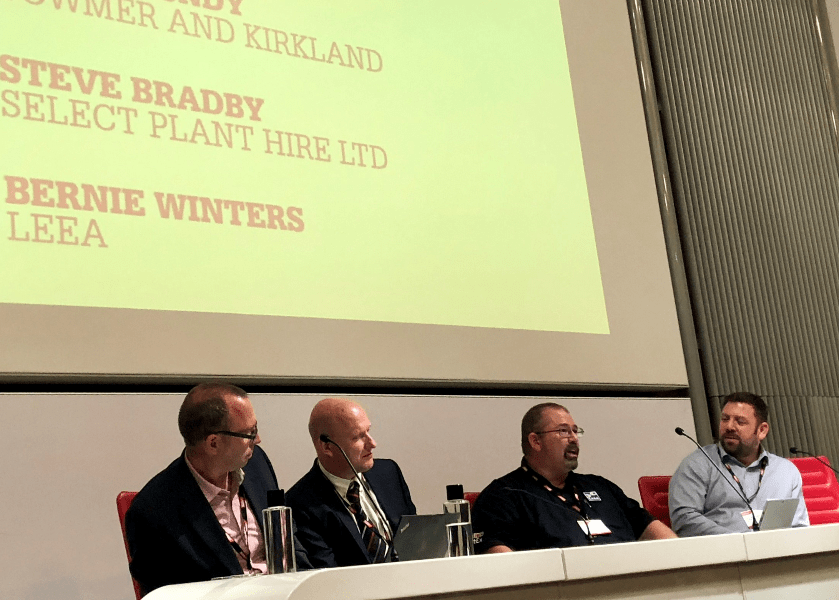
Impressive views on crane safety
Bernie Winter, Member Engagement Services (South), represented LEEA at the iMechE Crane Safety 2018 Conference, held at the Institute of Mechanical Engineers in London on 12 September 2018, and took part in the final question and answer session. He reports on what proved to be an extremely interesting and involving event.
Safety is paramount in our sector. Whether you are an operator or a handler the jobs are often very dangerous. So it was good to see iMechE’s Crane Safety 2018 Conference, which was aimed at raising safety standards for crane and lifting operations, drawing an impressive attendance featuring many large players from the lifting industry.
Jerrod King, an HM Specialist Inspector of Health and Safety (Mechanical Engineering) kicked off proceedings with his thoughts on planning and safe lifting operations. Stuart Smith, of Sparrows Group, followed with an overview of challenges and innovative solutions for the offshore renewable markets.
After these regulation and design talks came sessions on novel and complex lifting requirements including seminars on: tunnelling lifting operations by Costain’s Simon Steane, which examined the Tideway – a major new sewer to help tackle the problem of overflows from the capital's Victorian sewers; a case study on the installation of the Scarborough Bridge by Sam Pitt of Ainsborough Crane Hire; and Select Plant Hire’s Gavin Wilson and Jake Sharlotte gave an interesting insight into tall buildings via the Newfoundlands Project – a 60-storey residential tower in London’s Canary Wharf.
Three masterclasses conducted after lunch covered improving competency and managing human factors; materials and non-destructive examination; and, finally, legal responsibilities and managing risk.
The final part of the event focused on planning, safety and site control with a look at objects falling from height and risk reduction from Select Plant’s Thara Nixon and Steve Bradby and finally a question and answer panel addressing issues discussed throughout the day, with the aim of improving safety and reducing risk.
Throughout the day, observation from cranes was a key discussion point, with a lot of talk about hook cams, boom cams and identification. Despite their use not being a regulation, cams can certainly be incorporated as a safety device – but only as an aid. It should always be remembered that safety devices do not absolve everybody involved in the operation from responsibility for safety – the human factor still has to be seriously considered in all cases.
Nevertheless, crane operators can certainly see a massive safety improvement with cams. Even when operators are high up and have good view, there will still be blind spots. So while cams will not necessarily eliminate the risk of accidents happening but they can reduce the risk of incidents.
Another example of technology acting as an aid is a product currently under trial that will enable loads to be manoeuvred in offshore lifting with a reduced need for taglines and people standing in proximity to the load. While not totally eliminating risk, it certainly reduces the possibility of injuries.
An example of a case where this technology might help was raised during the seminar on tunnelling, which recounted an incident where a tunnel-boring machine slipped from its belly sling. In situations such as tunnelling, where equipment can slip and drop, space where people can escape to is very limited. If, using this technology, people are not required in such an area in the first place, that will significantly minimise the risk.
I’m definitely all for embracing technology but not as a be all and end all, because technology can fail. Getting people out of the way of loads being lifted remains the best way to prevent incidents.
Somewhat surprisingly, lift plans were a recurring issue through the day and cropped up again during the final question and answer session, in which I took part. According to LOLER, lift plans must be put in place and all lifts must be carried out safely, because in the event of an accident, as Jerrod King remarked in the opening seminar, the lift plan will be the first thing an HSE inspector will ask for.
Unfortunately, it seems lift plans can get taken for granted – particularly when it comes to forklift truck operations. A lift truck driver might simply pick a load up, turn round and transport it to another spot, but this is still a lifting operation. There needs to be a lift plan, whether it is a general lift plan for common lifts or something more specific. While a physical lift plan has to be in place, a daily reminder every morning during ‘toolbox talks’ will help, as will having a risk assessment folder available for everybody to read at any point and then be able to acknowledge that they have read it.
IMechE’s Crane Safety 2018 conference was very well attended with many really good questions being asked during the masterclasses and Q&A sessions. I congratulate the organiser and the conference chair, Tim Watson of the Construction Plant-hire Association, for providing open forums for the delegates to express their opinions, which are particularly useful in my view. I certainly found the conference to be beneficial and would recommend LEEA members visit next year. My hope is that more events addressing safety from a broad array of organisers will join it on the Lifting Industry calendar.



